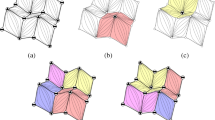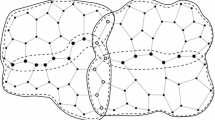Abstract
Hierarchical terrain models describe a topographic surface at different levels of detail, thus providing a multiresolution surface representation as well as a data compression mechanism. We consider the horizon computation problem on a hierarchical polyhedral terrain (in particular, on a hierarchical triangulated irregular network), which involves extracting the horizon of a viewpoint at a given resolution and updating it as the resolution increases. We present an overview of horizon computation algorithms on a nonhierarchical polyhedral terrain. We extend such algorithms to the hierarchical case by describing a method which extracts the terrain edges at a given resolution, and proposing a randomized algorithm for dynamically updating a horizon under insertions and deletions of terain edges
Similar content being viewed by others
References
Atallah M (1983) Dynamic computational geometry. In: Proceedings of the 24th Symposium on Foundations of Computer Science. IEEE Computer Society, Baltimore pp 92–99
Barrera R, Vaquez AM (1984) A hierarchical method for representing relief. In: Proceedings of the Pecora IX Symposium on Spatial Information Technologies for Remote Sensing Today and Tomorrow, Sioux Falls, South Dakota, pp 87–92
Boissonnat JD, Dobrindt K (1992) On-line construction of the upperenvelope of triangles in ℛ3. In: Wang CA (ed) Proceedings of the 4th Canadian Conference on Computational Geometry, St. John's, Newfoundland. Memorial, Newfoundland; pp 311–315
Boissonnat JD, Devillers O, Schott R, Tailland M, Yvinec M (1992) Application of random sampling to on-line algorithms in computational geometry. Discrete Computational Geom 8:51–71
Cazzanti M, De Floriani L, Nagy G, Puppo E (1991) Visibility computation on a triangulated terrain. In: Cantoui V, Ferretti M, Levialdi S, Stefanelli R (eds) Progress in image analysis and processing II. World Scientific Publishing, Singapore, pp 721–728
Chen ZT, Tobler WR (1986) Quadtree representation of digital terrain. In: Bresnahan P, Corwin E, Cowen D (eds) Proceedings Autocarto, London, pp 475–484
Clarkson KL, Shor PW (1989) Application of random sampling in computer geometry. Discrete Computational Geom 4: 387–421
Cole R, Sharir M (1989) Visibility problems for polyhedral terrains J Symbolic Computation 17:11–30
De Flonani L, Magillo P (1994a) Visibility algorithms on triangulated terrain models. Int. J. Geograph Inform Syst 8:13–41
De Floriani L, Magillo P (1994b) A randomized dynamic algorithm for computing the upper envelope of segments. Technical report PDISI-94-7, Dept of Computer and Information Science, University of Genoa, Italy
De Floriani L, Magillo P (1995) Computing the visibility map on a hierarchical triangle-based terrain model (in press)
De Floriani L, Puppo E (1992) A hierarchical triangle-based model for terrain description. In: Theories and methods of spatio-temporal reasoning in geographic space. Lect Notes Comput Sci 639:236–251
De Floriani L, Falcidieno B, Pienovi C (1984) A hierarchical data structure for surface approximation. Comput Graphics 8:475–484
De Floriani L, Mirra D, Puppo E (1993) Extracting contour lines from a hierarchical surface model. Comput Graphics Forum 12:249–260
Gomez D, Guzman A (1979) Digital model for three-dimensional surface representation. Geoprocessing, 1:53–70
Hershberger J (1989) Finding the upper envelope ofn line segments inO(n logn) time. Inform Proc Lett 33:169–174
Ponce J, Faugeras O (1987) An object-centered hierarchical representation for 3D objects: the prism tree. Comput Vis Graphics Image Process 38:1–28
Rippa S (1990) Minimal roughness property of the Delaunay triangulation. Comput Aided Geom Design 7:489–497
Samet H (1990) The design and analysis of spatial data structures. Addison-Wesley, Reading, Mass
Samet H, Sivan R (1992) Algorithms for constructing quadtree surface maps. In: Proceedings of the 5th International Symposium on Spatial Data Handling, Charleston, pp 361–370
Scarlatos LL (1990) An automatic critical line detector for digital elevation matrices. In: Proceedings of the 1990 ACSM-ASPRS Annual Convention, Denver, Colorado, pp 43–52
Scarlatos LL, Pavlidis T (1992) Hierarchical triangulation using cartographic coherence. Graphical models and image processing 54:147–161
Von Herzen B, Barr AH (1987) Accurate triangulations of deformed, intersecting surfaces. Comput Graph 21:103–110
Author information
Authors and Affiliations
Rights and permissions
About this article
Cite this article
De Floriani, L., Magillo, P. Horizon computation on a hierarchical triangulated terrain model. The Visual Computer 11, 134–149 (1995). https://doi.org/10.1007/BF01898599
Issue Date:
DOI: https://doi.org/10.1007/BF01898599




